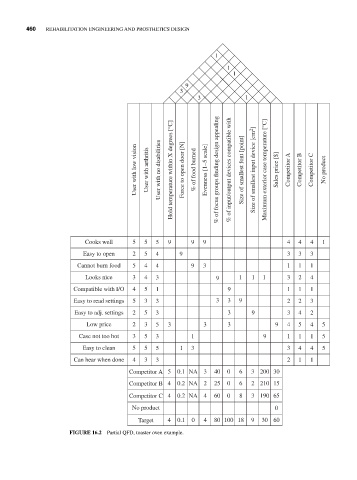Page 482 - Biomedical Engineering and Design Handbook Volume 2, Applications
P. 482
460 REHABILITATION ENGINEERING AND PROSTHETICS DESIGN
1
1
1
9
3
3 1
User with low vision User with arthritis User with no disabilities Hold temperature within X degrees [°C] Force to open door [N] % of food burned Evenness [1–5 scale] % of focus groups finding design appealing % of input/output devices compatible with Size of smallest font [point] Size of smallest input device [cm 2 ] Maximum exterior case tem
Cooks well 5 5 5 9 9 9 4 4 4 1
Easy to open 2 5 4 9 3 3 3
Cannot burn food 5 4 4 9 3 1 1 1
Looks nice 3 4 3 9 1 1 1 3 2 4
Compatible with I/O 4 5 1 9 1 1 1
Easy to read settings 5 3 3 3 3 9 2 2 3
Easy to adj. settings 2 5 3 3 9 3 4 2
Low price 2 3 5 3 3 3 9 4 5 4 5
Case not too hot 3 5 3 1 9 1 1 1 5
Easy to clean 5 5 5 1 3 3 4 4 5
Can hear when done 4 3 3 2 1 1
Competitor A 5 0.1 NA 3 40 0 6 3 200 30
Competitor B 4 0.2 NA 2 25 0 6 2 210 15
Competitor C 4 0.2 NA 4 60 0 8 3 190 65
No product 0
Target 4 0.1 0 4 80 100 18 9 30 60
FIGURE 16.2 Partial QFD, toaster oven example.

